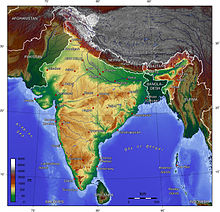Indian Himalayan Region
This article needs additional citations for verification. (November 2015) |

The Indian Himalayan Region (abbreviated to IHR) is the section of the Himalayas within India, spanning 13 Indian states and union territories, namely Ladakh, Jammu and Kashmir, Himachal Pradesh, Uttarakhand, Sikkim,[1] West Bengal, Arunachal Pradesh, Nagaland, Manipur, Mizoram, Tripura, Meghalaya and Assam.[2][3] The region is responsible for providing water to a large part of the Indian subcontinent and contains various flora and fauna.[4]
Physiographically, the IHR starts from the foothills of south (Shivaliks) and extends up to the Tibetan plateau on the north (Trans-Himalaya). Three major geographical entities, the Himadri (greater Himalaya), Himanchal (lesser Himalaya) and the Shiwaliks (outer Himalaya), extend almost uninterrupted throughout its length and are separated by major geological fault lines. Mighty but older waterways like the Indus, Sutlej, Kali, Kosi and Brahmaputra cut through the IHR's steep gorges to escape into the Great Plains, establishing their antecedence.
The northernmost range of mountains are the Karakoram Mountains that continue from India into Pakistan and China. To the south of the Karakoram Range lies parallel to the Zanskar Ranges and parallel to Pir Panjal Ranges. These three mountain ranges lie parallel to each other in the north-western part of India, most of its area lying in the state of Jammu and Kashmir as its capital Srinagar, too.
Some of the highest mountains on earth are found in the region. Many rivers considered holy like the Ganga and supplying 13th to draw a flow from the Himalayas.
Trans-Himalaya[]
Trans himalaya is created due to the collision with the Eurasian plate. This Zone is the northernmost area in the country in the states of Jammu and Kashmir , Uttarakhand and Himachal Pradesh. It is an extension of Tibetan plateau around the Himalayas. The Main Himalayan Ranges are as follows:
- Pir Panjal Range (part of middle Himalayas)
- Dhauladhar Range madya himalaya
- Zanskar Range
- Ladakh Range
- East Karakoram Range
- Mahabharata range (middle Himalayas in Nepal)
Pir Panjal Range[]
To the south of the main Himalayas lies the Pir Panjal Range at an average height of 5,000 metres (16,000 ft). From Gulmarg in the northwest it follows the southern rim of the Kashmir valley to the Banihal Pass. Here the Pir Panjal meets the ridgeline that separates the Kashmir valley from the Warvan Valley. The major passes here in Pir Panjal are the Pir Panjal Pass due west of Srinagar, the Banihal Pass which lies at the top of the Jhelum River at the southern end of the Kashmir valley, and the Sythan Pass linking Kashmir with Kishtwar and Salooni.
Dhauladhar Range[]
To the south of the Pir Panjal lies the Dhauladhar range. Both ranges are visible from Salooni of Chamba. It is easily visible because of its distinct feature of the snow-capped ridge, which forms the division between the Ravi and the Beas valleys. In the west it divides the Chenab valley and the Tawi Valley. Towards the east it extends across Himachal Pradesh forming the high ridges of the Large gorge and extending towards the south of the Pin Parvati Valley before it forms the ridgeline east of the Sutlej River. The rivers flow from it.
Zanskar Range[]
The Zanskar Range lies to the north of the main Himalaya. It acts as a backbone of Ladakh south of the Indus River, extending from the ridges beyond Lamayuru in the west across the Zanskar region; there it is divided from the main Himalaya by the Stod and Tsarap valleys, the Zanskar valley. On the east of the Zanskar region the range continues through the Lahaul and Spiti district and Pangi of the Chamba. While in the north it continues across the Kinnaur before extending towards west across Uttarakhand. Some of the main passes are the Fatu La, on the Leh-Srinagar road, while the main trekking passes into the Zanskar valley are Singge La, the Cha Cha La and the Rubrang La.
Ladakh Range[]
To the north of the Leh lies the Ladakh Range and it is an important part of the Trans-Himalayan range that merges with the Kailash Range in Tibet. Here the important passes are the famous Khardung La, and , which lie to the northeast of Leh.
East Karakoram Range[]
The Karakoram is a giant range, which geographically divides India and Central Asia. The range consists of high mountain peaks like Saltoro Kangri, Rimo and Teram Kargri. The Korakoram Pass acts as the main connector between the markets of Yarkand, Leh and Kashgar.
Shiwalik Hills[]
The southern most range of the Himalayas are the Shivaliks. Shivaliks extend over a width of 10–50 km, and have an altitude varying between 900 m and 1100 m.
These ranges are called by different names in different regions:
- Jammu hills in Jammu region
- Mishmi hills in Arunachal pradesh
- Cachar in Assom, etc.
These parts consist of thick gravel and alluvium.
The valley lying between the Lesser Himalayas and Shivalik ranges are called as duns. Dehradun,kotli dun and patli dun are some of the prominent Duns.
It is the southern most region of the Himalayas
References[]
- ^ O'Neill, Alexander; et al. (25 February 2020). "Establishing Ecological Baselines Around a Temperate Himalayan Peatland". Wetlands Ecology & Management. 28 (2): 375–388. doi:10.1007/s11273-020-09710-7. S2CID 211081106.
- ^ "Indian Himalayan Region - ENVIS Centre on Himalayan Ecology, GBPIHED".
- ^ "Indian Himalayan Region (IHR)".
- ^ Sustainable development of the Indian Himalayan region : Linking ecological and economic concerns
External links[]
 Himalayan North travel guide from Wikivoyage
Himalayan North travel guide from Wikivoyage- Resource Information Database of Indian Himalaya
- Regions of India